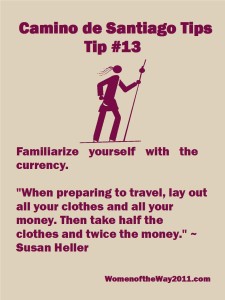 Familiarize yourself with the Spanish currency prior to leaving. Spain uses the euro, as do most European Union Countries. One euro has 100 cents. There are seven different notes and eight different coins.
Familiarize yourself with the Spanish currency prior to leaving. Spain uses the euro, as do most European Union Countries. One euro has 100 cents. There are seven different notes and eight different coins.
The notes are identical throughout Europe. They are differentiated by their size and color and come in denominations of € 5, € 10, € 20, € 50, € 100, € 200, and € 500. There are no one- or two-euro notes; instead, there are the one- and two-euro coins.
There are eight euro coins. Get accustomed to the look so you don’t have to read each coin to see the value. The common side of the coin portrays a map of Europe; the obverse differs for each Euroland member country. In Spain, the 1, 2, and 5 cent pieces feature the Cathedral of Santiago de Compostela; the 10, 20, and 50 cent coins honor Cervantes; and the euro coins have the face of King Juan Carlos I, the current King of Spain.
The euro notes and coins are interchangeable within the European Union countries.

Currency Exchange
In Spain, ATMs are called “cajeros automáticos.” Since there are ATMs in most airports, there is no need to buy currency prior to leaving home. I recommend exchanging only a nominal amount of money at the airport or train stations because they have the worst foreign currency exchange rates. There are ATMs all along the Camino, so exchanging money during hours that the banks are unopened is not problematic. Most ATMs have an English language option. Using ATMs will get you the best currency exchange rate. Be sure to use an ATM or debit card; do not use your credit card at the ATM because the transaction is recorded as a cash advance, which may incur additional fees. If you are using both a debit card and a charge card, make sure to keep them in separate places so as not to confuse the two at the ATM machine. Make sure your debit card has the Cirrus or Plus logo; these cards work at most ATMs in Europe. (Visa and MasterCards have these logos on them.)
Banks differ in fees associated with ATM use and currency conversion. Prior to leaving for your trip, research to find which bank gives you the better rates. Find out if there are daily withdrawal limits. If the limit is too low, check to see if you can have it raised. Note: There are ATMs that are not associated with banks. To avoid higher fees, use only ATMs associated with major banks.
When withdrawing money, make sure to get smaller denominations. Some vendors may not have the change for a large note. If you cannot specify the denomination at the ATM, ask for an odd number, such as 190€. So doing will ensure that you have smaller bills.
Always have cash with you; some places do not accept credit cards.
Credit Cards
Call your credit card company before you leave to inform them about your travel plans. This will prevent them from putting your card on hold for suspect charges.
When making purchases, use a credit card and not a debit card, to prevent cloning your card information. Debit cards are associated with your checking account and it is easier for thieves to drain your account before you know it has happened. Also, a credit card makes it easier to dispute charges and close an account. Make sure that the charges are in the local currency and not in dollars. Some merchants may do this and charge a hefty currency exchange rate. If the charge is in dollars, ask them to redo the transaction in the local currency.
Find a credit card that does not charge currency conversion fees. This could save you a lot of money.
Take along several credit cards and keep them in separate places. If one gets stolen, you have the backups.
I had no trouble using my Visa credit card when I traveled in Spain in 2011. Now, most of Europe is using Chip-and-PIN cards, which have a microchip in them. Many places still swipe the cards, but they may have to try several times to get it to function. Currently, the only Chip-and-PIN credit card available for the general public in the U.S. is the Globe Trek Rewards Visa from Andrews Federal Credit Union. You might ask your bank or credit union if they are offering this or cards with the EMV chip (EuroPay, MasterCard, and Visa). For more information on EMV, see Your Guide to Chip and Pin Technology
Travelers Checks
Travelers checks once considered the safest way to travel, are now more of a hassle than other forms of money. It may be difficult to find a place to accept them, especially if you are not at a bank during work hours. You may want to carry some as a backup or emergency money, but they are not practical for daily use.